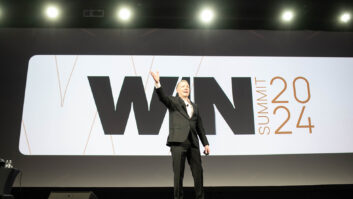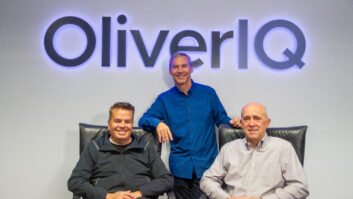Las Vegas — Motorola chairman and CEO Ed Zander said one of the company’s key challenges in the mobile and home-entertainment markets will be “moving from cool devices to cool experiences” in a keynote at the Consumer Electronics Show here Monday.
“It’s coming down to cool experiences,” he said. “How do I restart my TV [shows]? … How do I program my DVR [digital-video recorder] from this type of [mobile] device? How do I watch live TV [on my phone]?”
At the end of Zander’s presentation, he brought out Dan Moloney, president of Motorola’s Connected Home Solutions unit, who said Comcast will deploy the company’s FollowMeTV multiroom-DVR service in 2007. Moloney demonstrated the FollowMeTV technology streaming photos to TVs inside a networked home and also to mobile devices.
Now, Moloney said, “content goes with you. You never leave home without it.”
Zander asked him: “When is live TV is coming to Motorola’s devices?” “Soon,” replied Moloney. He described a demo Motorola is conducting at CES in which an Internet-protocol set-top box in San Diego is streaming live video, over the wireless network, to a Motorola Q handheld device.
In other announcements, Zander — whose keynote was titled, “Mobile ME: Internet Goes Airborne” — detailed a partnership Motorola has with Yahoo!, which created a mobile Internet service for Motorola’s RAZR MAX phone.
Called Yahoo! Go 2.0, the service provides local news and other content, Internet searching, Yahoo! e-mail and photos from Flickr.com, said Marco Boerries, senior vice president of Yahoo!’s Connected Life unit, whom Zander brought out on stage for a demo.
“For the first time, the Internet now fits your phone,” Boerries said. “Yahoo! Go brings Internet to your phone, not the other way around.” He added that the service will be available on 200 devices from Motorola and others by the end of 2007.
Zander also announced a wireless Bluetooth headset, MotoActv, which connects to Motorola mobile handsets. The headset, set to ship in the first half of 2007, includes controls for playing music or answering phone calls.
Chris White, Motorola’s senior director of multimedia experiences, announced a partnership with Warner Music Group to “re-create the album experience of the 70s and 80s.” The companies will sell retail music packages that include songs on removable memory cards — which can be plugged into Motorola phones — plus booklets with photos and information on new artists.
“This is more than what you can get from a 99-cent download,” White said.
Motorola also introduced a new music-oriented phone, the Motorizr Z6. The phone connects to Microsoft’s Windows Media Player application to synchronize content, and it allows users to buy music from more than 200 music stores worldwide.
For the enterprise mobile market, Zander demonstrated products from recent Motorola acquisition Good Technology, which makes software that lets corporate users access Microsoft Outlook messages from mobile phones.
Zander did not directly address the company’s announcement last week that it would miss its fourth-quarter financial targets. On Friday, Motorola said sales for the quarter would be in the range of $11.6 billion-$11.8 billion, compared with its previous estimate of $11.8 billion-$12.1 billion, and that net earnings would be lower than expected.
However, he alluded to the earnings shortfall with a joke. At the top of his keynote, Zander held up what he said was Motorola’s newest product: a clunky, decades-old cellular phone, which he said cost $4,000. After years of Motorola producing slim phones, he joked, “Fat is back.”
Quipped Zander: “I think the analysts here are going to like this … lots of gross-margin dollars in this puppy.”
Last week, Motorola attributed the shortfall to “an unfavorable geographical and product-tier mix of sales” for its mobile-devices group. “We are very disappointed with our fourth-quarter financial performance, but we remain committed to the strategic direction and long-term financial targets we discussed at our annual analysts’ meeting in July 2006,” Zander said in a Jan. 4 statement.
Analysts pointed to the earnings miss as evidence that mobile handsets are become commodity products with lower margins. Motorola has sold more than 50 million RAZR phones in two years, but in attempting to quickly gain market share, it cut prices.













